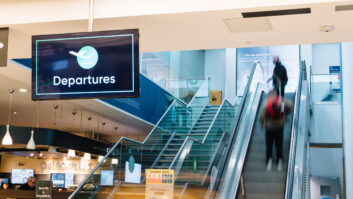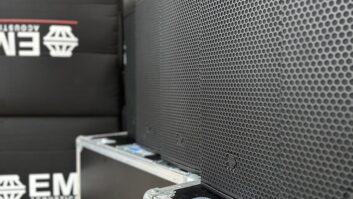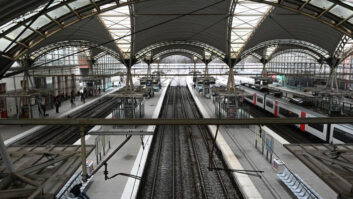
Reflecting on a trend that is now approaching the completion of its second decade, it is not too difficult to see why beam steering has proven so popular in the install market. Although there are numerous variations on the theme – to the extent that ‘steerable audio’ is arguably a more useful moniker, and therefore the one we will use here – the basic premise of being able to direct sound very carefully to where it is required has resonated strongly with client types ranging from conference centres and transport hubs to houses of worship.
The steerable audio phenomenon owes much of its momentum to the continued refinement and increased cost-effectiveness of DSP technology. Suitably harnessed, modern DSP makes it possible to shape the width and angle of acoustic beams emanating from loudspeakers, allowing installers to carefully direct audio to where it is required. As might be expected, the passage of time has seen the precision of these systems continue to improve, with a number of manufacturers enhancing the level of control offered over beam steering and splitting. From an initial customer base in small and medium-sized venues, steerable audio has increasingly been applied to larger facilities as well, thanks to the more recent introduction of systems that can deliver higher SPLs.
Surface details
If the basic principles of steerable audio were easily understood at the time solutions started to become commercially available, many observers might then also have foreseen the current ubiquity of the hard, reverberant surfaces that make such systems so invaluable to installers and their customers. Succinctly, the penchant of contemporary designers for huge glass and metal surfaces – and the reluctance by some to engage with acoustic issues until later in the process – has meant the opening up of huge potential demand for steerable solutions.
Ben Spurgeon is senior application engineer at Audiologic, which represents loudspeaker brands including Tannoy and Fohhn. “In today’s design-centric world, acoustics can often be an after-thought in venue/space design and can lead to multiple acoustic challenges,” he says. Consequently, “manufacturers are investing heavily in beam steering technology due to its technological benefits over traditional point source and line source solutions.”
With beam steering it is possible “to adapt the coverage of a given loudspeaker to alter the acoustic performance across a listening plane. In simple terms, this allows us to put sound where we need it, and avoid areas where it is not required. [Moreover] as computer processors become increasingly powerful, we are able to push the boundaries of what is currently possible with loudspeaker technology.”
The design challenges inherent in many houses of worship and transport hubs mean that these continue to be strongholds for manufacturers. But as price points have come down, and the ease of set-up and implementation of systems has improved, steerable audio has increasingly resonated with other areas of install as well as live concert/tour sound.
Renkus-Heinz is one of the most established manufacturers in this space, with its ICONYX beam steerable loudspeaker range now approaching its 15th birthday. Noting the continued buoyancy of applications “where high directivity and high intelligibility are [key] requirements, like traditional churches and transportation infrastructure,” technical sales manager Jim Mobley remarks that “on the production side, as steerable products continue to get louder, the aesthetic and quick set-up advantages of beam steering are being recognised by more and more production companies. [As a result] we do see lots of growth potential in production and live sound markets.”
Desired characteristics
Although the specifics of individual systems do vary considerably – particularly as competition and choice in the market have grown – the desired end results of deploying a steerable audio systems are relatively uniform. And as simulation software has become more powerful and versatile, these end results have become more straightforward to achieve.
“In an ideal world, we want to be able to create precise coverage areas with as little spill as possible outside of our configured lobes,” says Spurgeon. “As the technology has advanced we have gained further control over the shape of beams – to the point where single arrays can now form multiple separate beams. So in a theatre application, this means we can cover multiple balconies and seating areas while avoiding the hard reflective perimeter of the balcony, minimising interference reflections coming back towards the stage and loudspeakers.”
Configuring a system that is capable of controlling the required frequency range is critical. “The array must be tall enough to have sufficient directivity to effectively steer down to a frequency low enough for the application; that means about 1.5 to 2 wavelengths tall at the frequency of interest,” says Mobley. “So a 2ft tall (60cm) array can effectively steer from 800-1kHz and up – about the directivity control one would get from a medium-sized horn. Every time the height doubles, an octave of effective steering is gained. All other characteristics would be the same for any other loudspeaker type – sufficient fidelity, output, response and so on.”
Common mistakes
Given this, it’s not surprising to find that the most common errors in deploying steerable audio involve the specification of systems that are insufficiently large to cover the desired range. “If you have only three boxes in an array then it may well be that you cannot control the mid-low frequencies,” says Daniele Mochi, project support specialist at K-array. The company’s first product featuring Electronic Beam Steering technology was the Firenze-KH8 launched in 2014, and Mochi highlights the fact that K-array’s cabinets are mechanically designed in order to optimise the steering results.
Spurgeon highlights a specific instance where the laws of physics can sometimes be overlooked. “To allow for maximum gain before feedback, it is still best practice to place loudspeakers ahead of any microphone channels to maximise the off-axis rejection and minimise the chances of feedback,” he says. “Due to the directionality characteristics of the arrays, it can often be assumed that these can be placed above open microphones where traditional point source cabinets couldn’t. Although a true beam steering line source will behave better than a point source in this application, the laws of physics will still not allow for full off-axis rejection at low frequencies.”
Johannes Hinze works in acoustics and project management at TOA. He indicates that mistakes can occur when there is not sufficient collaboration between different stakeholders in a project, referencing an instance “where there was an installation on a train platform and it worked fine, until another installer placed a big sign in line of sight of the speaker without letting us know! Luckily, after realising the problem, we were able to adapt the speaker settings to the new environment. You do need co-operation between the different branches [working on a project].”
In any case, the basic installation of a system is invariably only one stage of the process, with a period of fine-tuning required to fully optimise its performance – and that calls for engineers with a thorough knowledge of acoustics. Hinze remarks that “beam steering is not a solution that works out of the box. You need to fine-tune it on-site, and that means you need a professional engineer after installation for correct setting up of the system.”
Spurgeon echoes these sentiments, observing that “the complexities and intricacies of beam steering loudspeakers” are such that projects require “system designers with a full understanding of the technology and its applications to be able to specify beam steering solutions. Due to the products not simply being ‘point and shoot’, a trained engineer with a full understanding of the software and venue is required to deploy these systems.”
Emerging markets
In general it appears that there are only a couple of obstacles to even wider adoption of steerable audio: the cost relative to traditional point source speakers (although prices are continuing to fall), and the self-powered nature of steerable arrays, meaning that AC mains has to be supplied to the loudspeakers – a requirement that can be problematic in some older venues. Overwhelmingly, though, the expectation is for beam steering to continue to grow in both its ‘core’ applications as well as some newer areas.
Adam Brown is business development manager – integrated solutions at UK-based distributor POLAR, whose primary steerable brand is Renkus-Heinz. Brown highlights the role of a new generation of compact systems in increasing the appeal of steerable audio to “corporate clients. We are doing a lot of work in that space, including meeting rooms and larger spaces. We also seem to be doing more and more cinema-based rooms, where steerable systems can be extremely handy.”
Spurgeon echoes the importance of the corporate market while also pinpointing the growing importance of live and tour sound. In a market where quick and cost-effective turnarounds are critical – particularly as the length and density of tours, especially by major artists, continues to grow – it’s no wonder that steerable systems are looking increasingly attractive.
“The corporate, theatre and live sound markets are an incredible growth area for beam steering,” he says. “With product introductions such as the Fohhn Focus Venue systems, beam steering technology is now lending itself to much larger applications such as stadium sound and rock concerts. These single vertical deployments make multi-venue setup much easier with a simple scalable solution which can simply be re-programmed in real-time for each individual venue, regardless of size. This additional layer of control, over traditional line arrays, gives the engineer another tool in their arsenal to better improve the consistency throughout the audience plane.”
Mochi underlines the continued demand for K-array solutions across the concert audio market, including “arenas, large parks and other outdoor venues – all those kinds of places where you need to cover big spaces”. The company is also continuing to spread awareness and understanding of steerable audio through the K-academy, its educational programme of workshops, seminars and courses covering every aspect of the audio experience and geared towards sound engineers, system integrators, architects, DJs and students.
Increasingly, deepening understanding of the technology is the name of the game since the fundamental benefits of steerable solutions are well-established and proven. Mochi draws a parallel with the emergence of digital audio, when “everyone was initially a bit scared about making the switch from analogue. But as more devices became available, more people felt comfortable with making the move to digital. Nowadays everyone is happy to work with digital audio, and I think the same kind of transition can be observed with beam steering.”
Not surprisingly, this degree of acceptance means that levels of competition in the market have also increased significantly, particularly during the last five to 10 years. But Mochi is not alone in concluding that “this is actually good news as the more that people have the opportunity to engage with beam steering products and understand their capabilities, the better it is for the industry. And with more and more steerable devices being made available, and with DSPs becoming more powerful too, the future looks very exciting indeed.”
www.audiologic.uk
www.k-array.com
https://polar.uk.com
www.renkus-heinz.com
www.toa.co.uk







